CIOs face a critical AI skills shortage, impacting initiatives and requiring strategic partnerships and training
As the race to harness AI’s transformative power by integrating AI tools intensifies, CIOs worldwide face a daunting obstacle: a critical shortage of skilled professionals. According to Expereo’s Enterprise Horizons 2024 research, which polled 650 leading technology leaders globally, over one-third of companies grapple with a significant skills deficit that threatens to derail their AI initiatives. This shortage is not just a minor inconvenience; it poses a substantial risk to the ambitious AI projects many organizations are eager to implement.The Underlying Challenge: Network Infrastructure
Beyond the immediate need for AI expertise, the foundational skills in data engineering, pipeline architecture, and network management have become increasingly vital. Crucially, nearly 40% of CIOs emphasize the importance of robust network infrastructures for scaling AI effectively. A well-optimized network can significantly enhance AI performance, ensuring seamless data flow and real-time processing, which is essential for AI-driven insights and automation. Even the most advanced AI systems can falter without these critical components, meaning they cannot deliver the expected results.
Given these complexities, partnering with the right technology providers is crucial. These partners offer advanced infrastructure and the expertise to optimize it, bridging the gap in networking talent and providing a scalable foundation for AI success. The right partnership can make the difference between a stalled project and a successful AI implementation that drives business growth and innovation.Addressing the Skills Gap: Strategic Approaches
CIOs must adopt a proactive, multifaceted strategy to tackle the AI skills shortage. This includes investing in employee development and forming partnerships with educational institutions and training programs.






